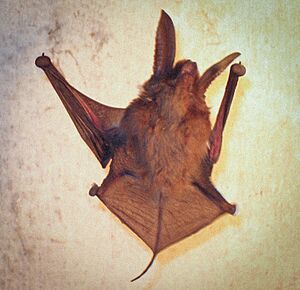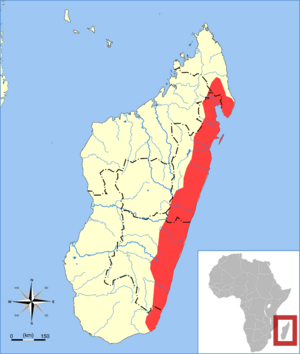Madagascar sucker-footed bat facts for kids
Quick facts for kids Madagascar sucker-footed batTemporal range: Pleistocene to Recent
|
|
|---|---|
 |
|
| Conservation status | |
| Scientific classification | |
| Genus: |
Myzopoda
|
| Species: |
aurita
|
 |
|
| Madagascar sucker-footed bat range | |
The Madagascar sucker-footed bat is a very special type of bat. It is also known as the Old World sucker-footed bat. This bat lives only on the island of Madagascar, especially in the eastern forests. It gets its name from the small, sticky pads on its wrists and ankles.
Scientists once thought this was the only bat of its kind. But then they found a second species, called Myzopoda schliemanni. The Madagascar sucker-footed bat was once thought to be in danger. Now, we know there are more of them, so they are listed as "Least Concern".
Sticky Secrets: How They Hold On!
These bats are famous for the special pads on their wrists and ankles. They use these pads to stick to the smooth, rolled leaves of the traveller's tree. People used to think the bats used suction to stick. But now we know they use something called "wet adhesion." This means they make a special body fluid that helps them stick.
Muscles control these sticky pads. This allows the bat to easily attach and unstick itself. Because of this amazing ability, the Madagascar sucker-footed bat is one of the few bats that sleeps with its head pointing up. Most bats sleep upside down. Sleeping head-up helps these bats keep control of their sticky pads while they rest.
Where They Live and What They Eat
Madagascar sucker-footed bats have a very unique home. They live inside the rolled leaves of the traveller's tree. Because these leaves are so smooth, tiny bugs called ectoparasites (like fleas or ticks) cannot live on them. This means these bats usually do not carry such parasites.
Most of these bats are found very close to groups of traveller's trees. They usually do not fly far from their homes to find food. Research shows they travel about 1.8 kilometers (about 1.1 miles) at most. These bats mainly eat beetles and small moths.


